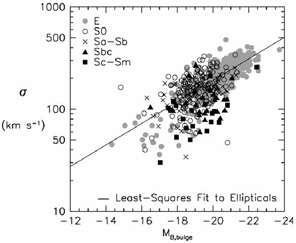Copyright © 2004 by Annual Reviews. All rights reserved
| Annu. Rev. Astron. Astrophys. 2004. 42:
603-683 Copyright © 2004 by Annual Reviews. All rights reserved |
4.7. Velocity Dispersions and the Faber-Jackson Relation
Figure 18 correlates velocity dispersion and
absolute magnitude for
elliptical galaxies and for bulges of disk galaxies. Most early-type galaxy
bulges are consistent with the well known correlation that bulge luminosity
LB 
 4
(Faber & Jackson
1976;
see Minkowski 1962
for an early
hint). But a few early-type bulges and a large majority of Sbc - Sm
"bulges" fall well below the correlation. One possible interpretation is
that the bulges of late-type galaxies are low in velocity
dispersion. This is disky
behavior. Alternatively, the late-type "bulges" may lie to the right of the
early-type systems because they are actively forming stars and therefore
have small mass-to-light ratios. Figure 18 then
implies that most late-type bulges have young stellar population
ages. This means that the star formation must be
secular, not episodic. In either case, Figure 18
suggests that most late-type galaxies contain pseudobulges. In contrast,
most early-type bulges are similar to elliptical galaxies.
4
(Faber & Jackson
1976;
see Minkowski 1962
for an early
hint). But a few early-type bulges and a large majority of Sbc - Sm
"bulges" fall well below the correlation. One possible interpretation is
that the bulges of late-type galaxies are low in velocity
dispersion. This is disky
behavior. Alternatively, the late-type "bulges" may lie to the right of the
early-type systems because they are actively forming stars and therefore
have small mass-to-light ratios. Figure 18 then
implies that most late-type bulges have young stellar population
ages. This means that the star formation must be
secular, not episodic. In either case, Figure 18
suggests that most late-type galaxies contain pseudobulges. In contrast,
most early-type bulges are similar to elliptical galaxies.
 |
Figure 18. Correlation between central velocity dispersion and bulge absolute magnitude for all galaxies of the indicated Hubble types that have velocity dispersions tabulated in Hypercat. The straight line is a least-squares fit to the ellipticals. Updated from Kormendy & Illingworth (1983), this figure is from Kormendy & Cornell (2004). |